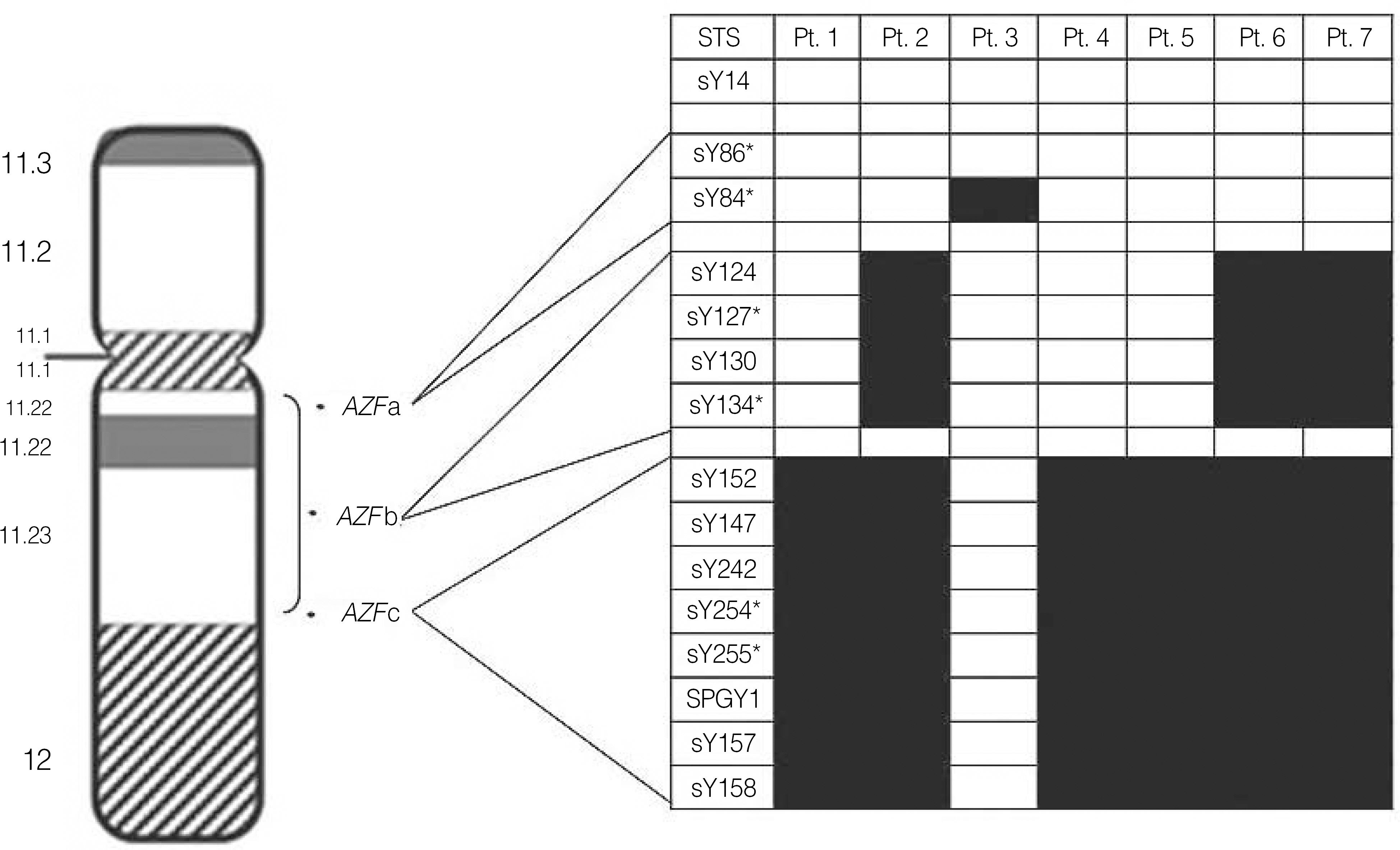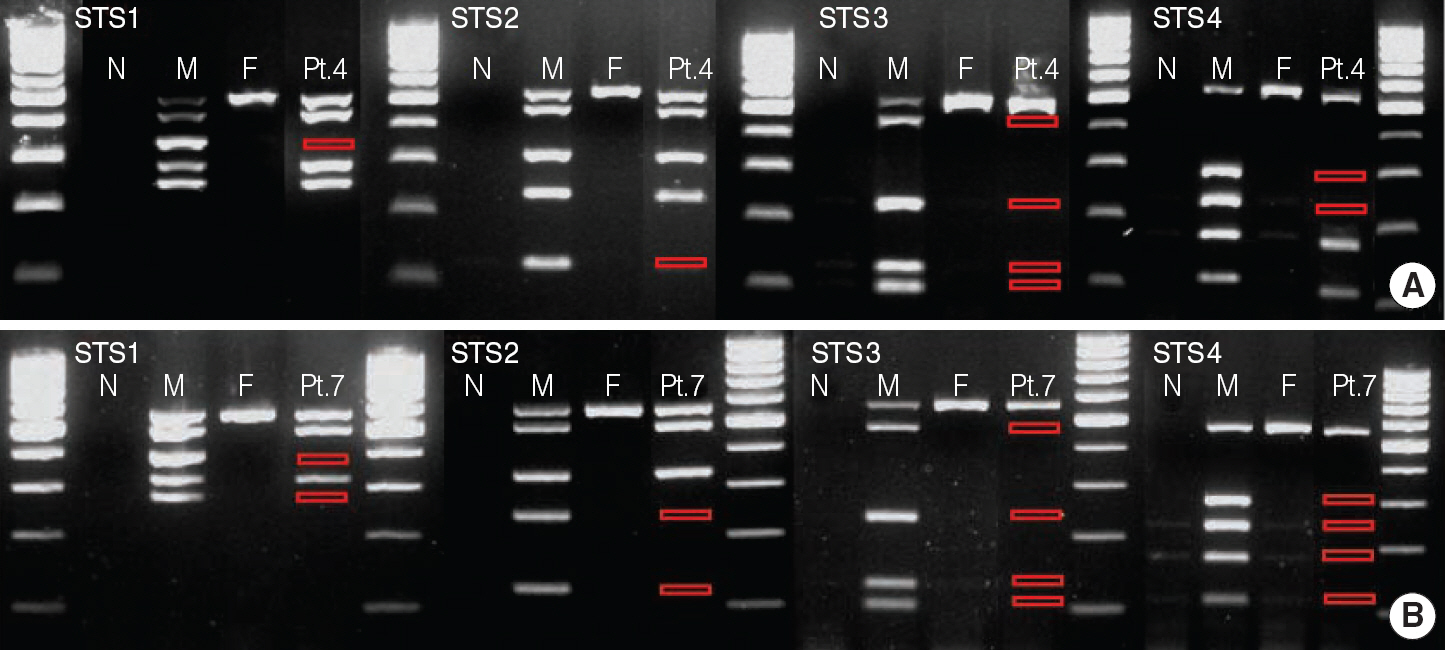Korean J Lab Med.
2010 Aug;30(4):432-439. 10.3343/kjlm.2010.30.4.432.
Evaluation of a Multiplex PCR Kit Used for Detecting Y Chromosome Microdeletions
- Affiliations
-
- 1Department of Laboratory Medicine, Pusan National University School of Medicine, Busan, Korea. kwanlee@dongguk.edu
- 2Department of Medicine, Pusan National University School of Medicine, Busan, Korea.
- 3Department of Urology, Pusan National University School of Medicine, Busan, Korea.
- 4Department of Pathology, Pusan National University School of Medicine, Busan, Korea.
- 5Medical Research Institute, Pusan National University Hospital, Busan, Korea.
- KMID: 1781651
- DOI: http://doi.org/10.3343/kjlm.2010.30.4.432
Abstract
- BACKGROUND
In addition to Klinefelter's syndrome, microdeletion of Yq is the most common genetic cause of male infertility; 15% of azoospermic or 5-10% of oligozoospermic males have Yq deletions. We evaluated a Yq microdeletion kit (LG Life Sciences, Korea) for identifying microdeletions in the azoospermic factor (AZF) regions of the Yq.
METHODS
The kit was designed to amplify 3 regions of the AZF gene (AZFa, AZFb, and AZFc) using 15 sequence-tagged sites. We evaluated the preclinical performance of the kit. For clinical validation, 58 patients including 25 idiopathic azoospermic or oligozoospermic patients were examined.
RESULTS
We observed clear bands on electrophoresis of DNA, up to a DNA concentration of 3.12 ng/microliter; the known microdeletion regions of all 6 reference cell-lines (Coriell, USA) were accurately detected and no false positive/negative results showed with normal female (n=11) and fertile male (n=15) specimens. This kit could identify the same microdeletions in the common regions, similar to another commercial kit. Among the 58 male infertile patients, 7 (12.1%) had microdeletions of the Yq. Among the idiopathic azoospermic (n=22) and oligozoospermic (n=3) patients, 3 (12.0%) had microdeletions. Further, 2 of 21 varicocele patients (9.5%), 1 of 4 patients with testicular failure, and 1 patient with a 45,X/46,XY mosaic had microdeletions.
CONCLUSIONS
The kit was effective for detecting microdeletions of the Yq. We identified microdeletions in 12% of the infertile patients. This Y chromosome microdeletion detection kit is useful for screening Yq microdeletions in infertile patients.
Keyword
MeSH Terms
-
Azoospermia/genetics
*Chromosome Deletion
*Chromosomes, Human, Y
Electrophoresis, Agar Gel/methods
Female
Humans
Infertility, Male/genetics
Male
Oligospermia/genetics
Polymerase Chain Reaction/*methods
Reagent Kits, Diagnostic
Reproducibility of Results
Seminal Plasma Proteins/*genetics
Sensitivity and Specificity
Varicocele/genetics
Figure
Reference
-
1.Foresta C., Moro E., Ferlin A. Y chromosome microdeletions and alterations of spermatogenesis. Endocr Rev. 2001. 22:226–39.
Article2.Korea Institute for Health and Social Affairs. http://www.kihasa.re.kr. (Accessed on April. 2010.3.Dada R., Gupta NP., Kucheria K. Yq microdeletions—azoospermia factor candidate genes and spermatogenic arrest. J Biomol Tech. 2004. 15:176–83.4.Tiepolo L., Zuffardi O. Localization of factors controlling spermatogenesis in the nonfluorescent portion of the human Y chromosome long arm. Hum Genet. 1976. 34:119–24.
Article5.Vogt PH., Edelmann A., Kirsch S., Henegariu O., Hirschmann P., Kiesewetter F, et al. Human Y chromosome azoospermia factors (AZF) mapped to different subregions in Yq11. Hum Mol Genet. 1996. 5:933–43.
Article6.Land JA., Evers JL. Risks and complications in assisted reproduction techniques: Report of an ESHRE consensus meeting. Hum Reprod. 2003. 18:455–7.
Article7.Mitra A., Dada R., Kumar R., Gupta NP., Kucheria K., Gupta SK. Screening for Y-chromosome microdeletions in infertile Indian males: utility of simplified multiplex PCR. Indian J Med Res. 2008. 127:124–32.8.Simoni M., Bakker E., Krausz C. EAA/EMQN best practice guidelines for molecular diagnosis of y-chromosomal microdeletions. State of the art 2004. Int J Androl. 2004. 27:240–9.
Article9.Kuroda-Kawaguchi T., Skaletsky H., Brown LG., Minx PJ., Cordum HS., Waterston RH, et al. The AZFc region of the Y chromosome features massive palindromes and uniform recurrent deletions in infertile men. Nat Genet. 2001. 29:279–86.
Article10.Repping S., Skaletsky H., Brown L., van Daalen SK., Korver CM., Pyntikova T, et al. Polymorphism for a 1.6-Mb deletion of the human Y chromosome persists through balance between recurrent mutation and haploid selection. Nat Genet. 2003. 35:247–51.
Article11.Y chromosome microdeletion detection kit. Seoul, Korea: LG Life Sciences, Ltd.;2009. Sep. Package insert.12.Simoni M., Bakker E., Eurlings MC., Matthijs G., Moro E., Muller CR, et al. Laboratory guidelines for molecular diagnosis of Y-chromosomal microdeletions. Int J Androl. 1999. 22:292–9.
Article13.Ferlin A., Arredi B., Foresta C. Genetic causes of male infertility. Reprod Toxicol. 2006. 22:133–41.
Article14.Cram DS., Osborne E., McLachlan RI. Y chromosome microdeletions: implications for assisted conception. Med J Aust. 2006. 185:433–4.
Article15.Krausz C., Forti G., McElreavey K. The Y chromosome and male fertility and infertility. Int J Androl. 2003. 26:70–5.16.Sadeghi-Nejad H., Farrokhi F. Genetics of azoospermia: current knowledge, clinical implications, and future directions. Part II: Y chromosome microdeletions. Urol J. 2007. 4:192–206.17.Krausz C., Quintana-Murci L., McElreavey K. Prognostic value of Y deletion analysis: what is the clinical prognostic value of Y chromosome microdeletion analysis? Hum Reprod. 2000. 15:1431–4.18.Ferlin A., Moro E., Garolla A., Foresta C. Human male infertility and Y chromosome deletions: role of the AZF-candidate genes DAZ, RBM and DFFRY. Hum Reprod. 1999. 14:1710–6.
Article19.Hopps CV., Mielnik A., Goldstein M., Palermo GD., Rosenwaks Z., Schlegel PN. Detection of sperm in men with Y chromosome microdeletions of the AZFa, AZFb and AZFc regions. Hum Reprod. 2003. 18:1660–5.
Article20.Peterlin B., Kunej T., Sinkovec J., Gligorievska N., Zorn B. Screening for Y chromosome microdeletions in 226 Slovenian subfertile men. Hum Reprod. 2002. 17:17–24.
Article21.Oates RD., Silber S., Brown LG., Page DC. Clinical characterization of 42 oligospermic or azoospermic men with microdeletion of the AZFc region of the Y chromosome, and of 18 children conceived via ICSI. Hum Reprod. 2002. 17:2813–24.
Article22.Bhasin S. Approach to the infertile man. J Clin Endocrinol Metab. 2007. 92:1995–2004.
Article23.Enciso M., Muriel L., Fernandez JL., Goyanes V., Segrelles E., Marcos M, et al. Infertile men with varicocele show a high relative proportion of sperm cells with intense nuclear damage level, evidenced by the sperm chromatin dispersion test. J Androl. 2006. 27:106–11.
Article24.Rao L., Babu A., Kanakavalli M., Padmalatha V., Singh A., Singh PK, et al. Chromosomal abnormalities and y chromosome microdeletions in infertile men with varicocele and idiopathic infertility of South Indian origin. J Androl. 2004. 25:147–53.
Article25.Dada R., Kumar R., Shamsi MB., Sidhu T., Mitra A., Singh S, et al. Azoospermia factor deletions in varicocele cases with severe oligozoospermia. Indian J Med Sci. 2007. 61:505–10.
Article
- Full Text Links
- Actions
-
Cited
- CITED
-
- Close
- Share
- Similar articles
-
- Genetic Screening for Chromosomal Abnormalities and Y Chromosome Microdeletions in 846 Infertile Korean Men
- Evaluation of the AccuPower® RV1 Real-Time RT-PCR Kit and the AccuPower® RV1 Multiplex Kit for SARS-CoV-2 and Influenza Virus Detection
- Prevalence of Y chromosome microdeletions among infertile Mongolian men
- Evaluation of Multiplex Polymerase Chain Reaction Assay for the Simultaneous Detection of Sexually Transmitted Infections Using Swab Specimen
- Y chromosome microdeletions in idiopathic azoospermia and non-mosaic type of Klinefelter syndrome




